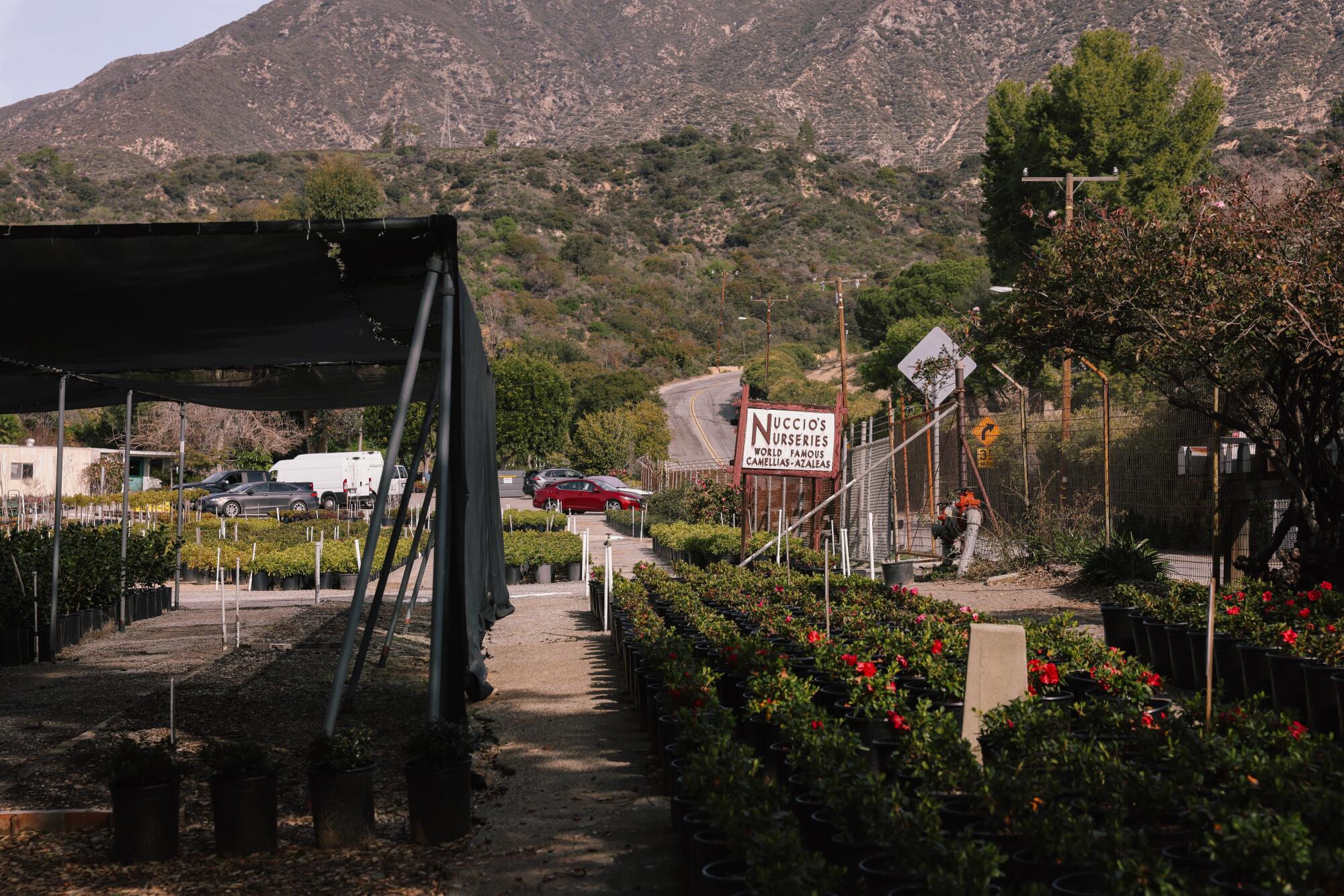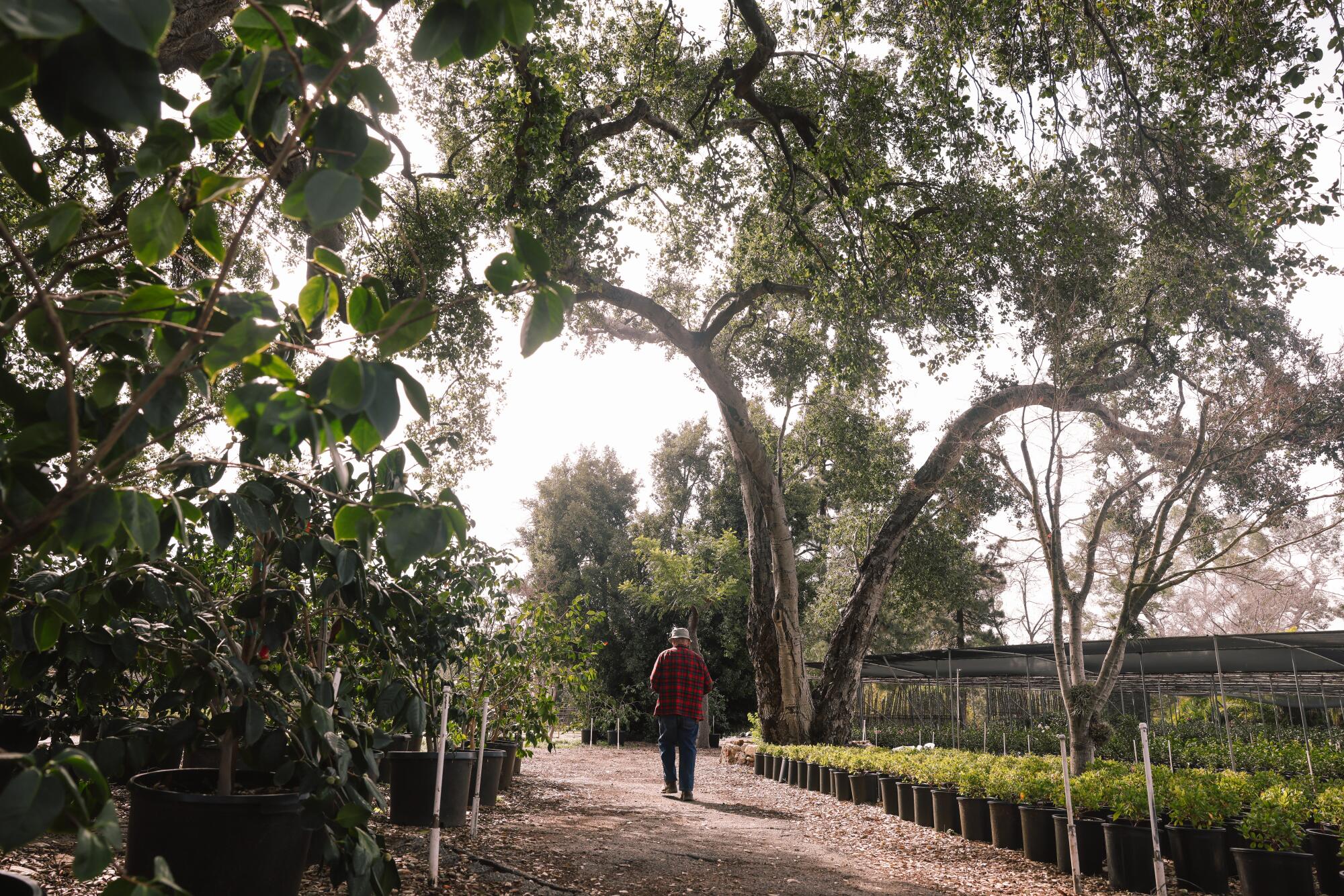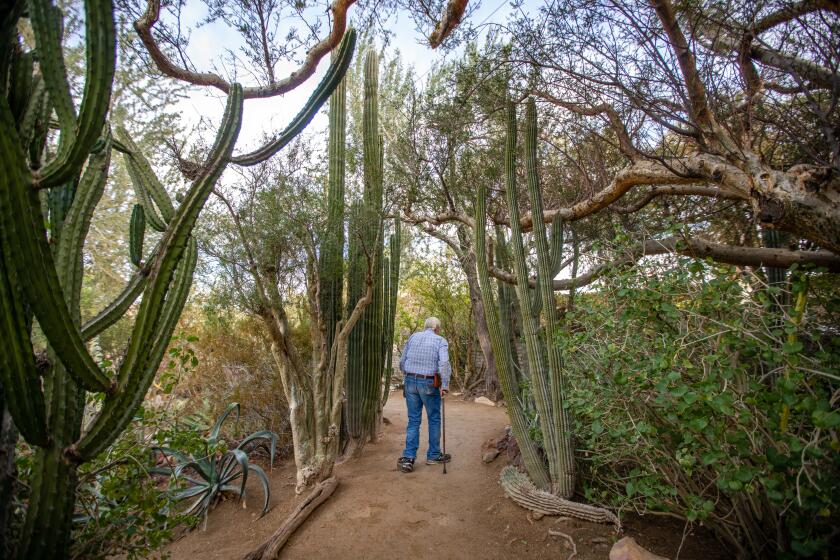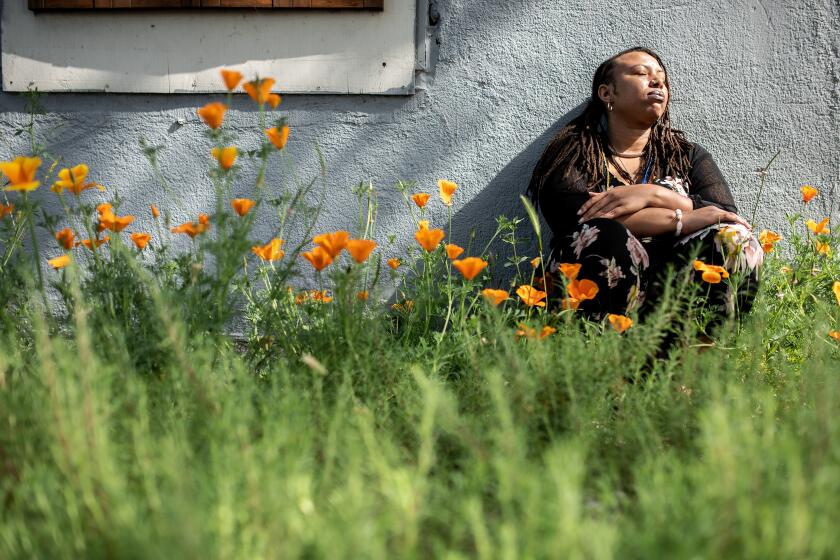
- Share via
Brothers Tom and Jim Nuccio have devoted a lifetime to cultivating exotic beauties, but you’d never know it from their clothes — well-worn jeans and work shirts that have gotten their patina honestly, through 10- to-12-hour days at Nuccio’s Nurseries in Altadena, the modest yet internationally famous camellia and azalea nursery that began in their grandparents’ Alhambra backyard in 1935.
As the business grew, Nuccio’s Nurseries moved to the rustic, semi-wild location where it is today, a sprawling site pushing into the undeveloped foothills above Altadena along the narrow Chaney Trail Road. The grounds are edged with towering oaks and eucalyptus and camellias planted so long ago that they are now graceful trees instead of shrubs.
The nursery sells more than 500 varieties of camellias and azaleas. The best time to appreciate the diversity is from January through March, when most of the plants are blooming. Then, you can wander through the rows, marveling at the forms — some frilly like peonies, multi-petaled like roses or open-faced like anemones, in colors ranging from lipstick reds to the faintest pinks and clearest whites. There are coral colors too, and even butter yellow. Some have gradient hues or stripes and can be bigger than your hand or as dainty as boutonnieres.
This time of year, the flowers are done, so all visitors see is acres of staid, glossy-leaved shrubs in 5-gallon pots. To glimpse the blooms, you need to look at photos, or even Martha Stewart’s website, where she waxes rhapsodic about the Nuccio’s camellias she grows in her New York greenhouse for wintertime blooms.
Sign up for our L.A. Times Plants newsletter
Get a monthly roundup of upcoming plant-related activities and events in Southern California, along with links to tips and articles you may have missed.
You may occasionally receive promotional content from the Los Angeles Times.
But the plants still need potting and tending, and the brothers, both in their 70s, run the place by themselves these days. Their third partner and cousin, Julius Nuccio, died of cancer in 2020, and there’s no new generation waiting to step in.


Which is a problem, of course, but it’s hard to get these sturdy, good-humored men to talk seriously about anything, let alone the closure of the business that’s sustained their family for nearly 90 years.
“Tom never married,” Jim explains solemnly, “and has no children ... that we know of.”
“Ha ha,” Tom retorts, and the two men laugh, but this is the heart of the matter: Even though Jim and their cousin Julius did marry and had three children each, none of their offspring wants to take over the nursery the way Julius, Tom and Jim did when their grandparents and fathers stepped aside.
Moorten Botanical Garden is an endearing, quirky vestige of old Palm Springs where even the admission price feels like a remnant of the past.
One of his sons might have been willing, Jim said, but backed away when he realized that he’d be in the business alone and that he couldn’t afford to buy the others out. These days, there’s more money to be had selling land than raising tropical shrubs whose popularity has waned in dry, water-parched Southern California.
That’s why the family announced in October that it’s selling all its property, including the 6-acre nursery, 7 acres of adjoining usable land and 65 undeveloped wild acres, to the Polytechnic School, a.k.a. Poly, in Pasadena — a 115-year-old K-12 private school in need of land for athletic fields and areas to conduct outdoor education and environmental science.


Julius’ son, Joe, said in an email that he organized the sale to Poly after his father died, once the family determined this was the best way to proceed. “Our family believes in Poly’s values and is confident they will put the land to good use, while at the same time protecting the environment,” he wrote. “Having owned the land for 75 years, we’re thrilled at the prospect of hundreds of children and their families learning and playing on this land over the next 75 years ....”
Some nearby residents aren’t so thrilled and have formed a group, Altadena Wild, to oppose the sale, claiming the school’s plans will create noise and traffic nightmares for neighbors and wreak havoc on the adjacent wild lands.
Poly Principal John Bracker said the school has committed to permanently preserving the undeveloped 65 acres for open space and trails and using the nursery area for sports fields, athletic events and environmental education classes.
During the pandemic, Rachel Nafis worked as an ER nurse. Burned out, she turned to flower farming and learned that being a florist is about more than just flowers.
The closure won’t happen this week, or even this year. Jim said the arrangement the Nuccios made with Poly gives them a year to vacate the business from the time escrow closes, although no one seems sure about when that will happen. There’s still an environmental impact report to complete, more meetings to be held and approvals to be won. Meanwhile, the opposition is floating other ideas, such as finding someone to buy the land for permanent conservation or bankroll another nursery there.
The brothers feel torn. They’re friendly with everybody, Jim said, so they aren’t taking sides. “All we ask is that people just be civil and factual.”

Jim said he likes to tease people who call, breathlessly asking, “‘Are you still in business? How much longer?’ and I say, ‘Well, by 4:30 today it’s over, so you better get down here.’” He laughs. “They scream, ‘What?!’ and then I tell them, ‘No, no, don’t rush up. We’re still here for the count.”
The Wallis Annenberg Wildlife Crossing over the 101 freeway won’t open till late 2025, but the work of collecting native seeds and building a nursery to grow them has begun.
But the clock is ticking. Even if the deal with the school falls through, “the other side of the family still wants to sell, so the business will be gone one day for sure,” Jim says. “For every one of our customers, this nursery has always been here, so it’s kind of a hollow feeling, but everybody realizes that it had to happen someday. Nobody would buy this as a nursery unless they take it over as a hobby.”
Neither the Nuccios nor school officials will confirm the sale price, but it’s well into the millions — clearly far more valuable than growing and selling camellias. The situation is particularly poignant for Tom, who lives in the little house on the property where their grandparents used to stay to help care for the plants.
“Yes, I’m going to be a millionaire,” Tom said wryly, “but I’ll also be homeless.”

It was Tom and Jim’s father, Julius, who really started the business, the brothers said. He fell in love with camellias and by age 11 knew they were his future. He got a job working at a nursery that grew camellias, and in 1935, when Julius was 17, he started propagating camellias in the backyard of the family’s Alhambra home, with help from his mother, Katherine “Katie” Nuccio, father Giulio and older brother Joe.
During World War II, Joe went to work at the shipyard in Long Beach and Julius was sent overseas to fight, but the family kept the operation going. When Julius returned, they decided the backyard was getting too small for the nursery, so Guilio purchased 38 acres for cheap in Altadena where they could spread out and really breed and grow camellias. (They were able to buy 40 additional acres in the 1960s.) For a while, Joe was growing some camellias at his home in Santa Monica — hence the name Nuccio’s Nurseries — but by 1946, the operation had consolidated in Altadena, where it’s operated ever since.
In a densely populated Watts neighborhood desperately lacking green space, a Los Angeles garden is designed to facilitate healing and honor loved ones lost to violence.
It took a while for their sons to get on board. Joe’s son Julius was first to get involved. While Tom and Jim grew up working summers at the business, they stepped away for awhile to go to college. Tom studied philosophy and briefly considered the seminary. Jim had a brief stint in the Army and then punched keys for a few years, back when data were stored on punch cards. But by 1981, they had both joined the family business.
The years crept up on them, but despite their age, Tom and Jim move around the nursery like wiry teenagers, lugging heavy pots filled with soil and plants, answering the phone that never stops ringing or writing up receipts by hand, because they don’t take anything but cash or checks. “It’s kind of the Stone Age here,” said Tom, pointing to a dusty hand-cranked adding machine on the counter. “We tell people we’ll take any card that works with this.”
None of the partners ever studied horticulture at school, Tom said. “On-the-job training is all you need here.”


Tom, the eldest, is 76, and the most mischievous, with thick rough hands so cracked and scarred that they look like the before photo for a miracle salve. But get him to hold one of the nearly 200 varieties his family has created — like Nuccio’s Gem, a white camellia so perfectly formed that it looks like chiseled marble — and his face softens like he’s holding a baby.
“We call it the Chanel of flowers,” he says tenderly, and you get a glimpse into how some seemingly boring shrubs have captured their hearts for so many years.
See, we’re not just talking about plants here. For generations, camellias have inspired passion and art — French author Alexandre Dumas’ famous 1848 novel “La Dame aux Camélias” (The Lady of the Camellias) centered on a doomed courtesan who wore camellias to signal her availability — red when she was menstruating and closed for business; white when she was available. The story inspired Italian composer Giuseppe Verdi’s opera “La Traviata” in 1853 and many English productions as “Camille,” including the acclaimed 1936 movie starring Greta Garbo.
Today’s lesson in L.A.’s changing landscapes is a modern-day parable about the joys and challenges of creating native habitats on public lands.
Before camellias were cultivated for their blooms, however, around 1700 BC, the Chinese discovered that the leaves of Camellia sinensis made a lovely drink. They’re still used today to make green, oolong and black teas. The Japanese are credited with developing ornamental varieties, such as Camellia japonica and the fall-blooming Camellia sasanqua. Those plants were cultivated in Europe and then America in the early 1700s and 1800s, first by conservatories and the very wealthy and later as flower crops and eventually landscape plants in the Southeast U.S. and, of course, balmy California.
These days, camellias are probably best known as museum flowers in Southern California, part of renowned collections at Descanso Gardens and the Huntington Library, Art Museum, and Botanic Gardens. But in the mid-1960s and ‘70s, they became a landscaping staple. Chances are, if your house or building has mid-century landscaping, there’s an ornamental camellia growing somewhere on the property, since its glossy dark-green leaves are handsome year round.
They’re slow-growing, Tom said, and have fallen out of fashion today. People mistakenly think the plants are water hogs, he said, but once established, camellias are very drought tolerant, requiring only occasional deep watering and a dose of cottonseed meal to thrive. They can get tree-size, he said, but many varieties of camellias and azaleas also do well in pots.
The Nuccios expect to have at least one more winter when customers can visit when the plants are in bloom, but once the nursery closes, yet another slice of L.A.’s rich horticultural history will be lost, said Bradford King, retired USC psychologist and president of the Southern California Camellia Society.

King, who has known the Nuccio brothers for more than 30 years, is a regular at the nursery, adding unusual varieties to his own collection. It’s sad enough, he said, that as these specialty nurseries close, gardeners will be left with only the more generic selections offered by big box nurseries. But even worse will be the loss of that prime collection of flower breeding stock.
The Nuccios have introduced some 200 new varieties of camellias, but only a few of those hybrids were deliberately made, King said. Most were created by bees, happy accidents of cross pollination among thousands of camellias blooming in the same space, and the keen eyes of the nurserymen looking for beautiful and/or unusual new flowers to nurture and propagate.
It takes about five years to develop new varieties from seed and get them big enough to sell in 5-gallon pots, Jim said. That’s a lot of time spent coaxing seedlings, mixing soil, watering and repotting and keeping an eye out for disease or damaging weather, since almost all of their operation is outdoors. Which is why Tom and Jim are still at work when the nursery is closed on Wednesdays and Thursdays, watering, potting, prepping plants for mail order shipments or driving big orders to nurseries and customers to the north and south.
During the off season, from June 1-Dec. 31, they’re supposedly closed on Sundays too, but even though the gates are closed, Tom and Jim are still on the job. “I talked to Jim the other day, and he said he finally had his first Sunday off in months, but he was going in anyway for a few hours to move some plants,” King said, “and they are there early every day, at 5 a.m.”
This is largely why many family-owned specialty breeding nurseries are disappearing, said David MacLaren, retired curator of the Huntington’s Asian gardens. “It’s a big commitment of time, and the cost of land has gone up so high, they can make more money selling the land and investing the money.”


Jim and Tom don’t like to talk about these things. For better or for worse, this is their life, and they clearly love what they do. So while the tempest about the sale swirls around them, the brothers are just carrying on, trying to stay above the fray with a “what will be, will be” kind of attitude.
“No one’s happy we’re leaving, but everybody is realizing it had to happen some day,” Jim said. “We’re still propagating every day like normal, just in case the sale doesn’t go through, and we’ll definitely be here into 2024, but it’s kind of a weird deal for us. Neither of us has an exit strategy. We’re too young to do nothing after working 90-hour weeks for so many decades ... maybe we’ll have to think about donating our time at the Huntington .... I’ll just show up there and say, ‘Hand me a rake.’”
More to Read
Sign up for The Wild
We’ll help you find the best places to hike, bike and run, as well as the perfect silent spots for meditation and yoga.
You may occasionally receive promotional content from the Los Angeles Times.
















